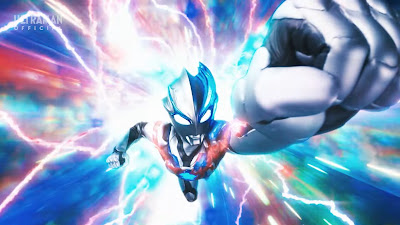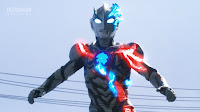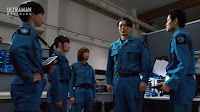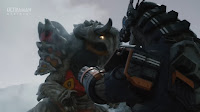After 25th anniversary celebrations of both Ultraman Tiga and Ultraman Dyna in the form of Ultraman Trigger: New Generation Tiga and Ultraman Decker, it was fair to assume that Ultraman Gaia would receive similar treatment for the Ultraman series in 2023. However Tsuburaya Productions aren't always that predictable, and after director Kiyotaka Taguchi (Ultraman X, Ultraman Orb, Ultraman Z) decided that replicating a show as good as Gaia was a near-impossible task, he instead sought to create a brand new series from the ground up. That series was Ultraman Blazar, the 35th entry in the Ultra Series and fifth to be produced in the Reiwa era. As has been the case for the last few years Blazar was simulcast worldwide via the official Ultraman YouTube channel, but this time TsuPro went one step further. In addition to simulcast subtitles in a variety of languages, English (starring Power Rangers alumni Johnny Yong Bosch in the lead role), Mandarin Chinese, Cantonese, Taiwanese Mandarin, Thai, Indonesian, Malay and Hindi dubs were also produced and released at the same time. When Tsuburaya said they wanted to bring Ultraman to the world more than ever before, they really meant it.
In 1966, nations all around the world established the GGF (Global Guardian Force) in response to the worldwide outbreak of kaiju disasters. In the present day attacks from both kaiju and extraterrestrial lifeforms continue, and during an attack on Ikebukuro by the space crustacean monster Bazanga a GGF cleanup crew led by Gento Himura is called in. When the operation goes south, a strange device materialises around Gento's wrist and he suddenly transforms into a giant of light - Ultraman Blazar!
While Gento's identity as Ultraman Blazar remains a secret, he is soon transferred to lead SKaRD (Special Kaiju Reaction Detachment) - a newly formed team also also commands the powerful robot Earth Garon. As SKaRD continue to defend Japan from monster attacks, they begin to uncover a conspiracy that may explain the rise in extraterrestrial attacks - as well as Gento's first encounter with Blazar three years prior.
As much as Ultraman's adherence to continuity and weaving all its series into one big (often complicated universe) can be a strength that sets it apart from its closest competitors, it can also work to its detriment when it comes to casting the net wide and trying to capture a new audience. Nearly every instalment in the New Generation run of shows has had some legacy attachment, whether it's through its story or its gimmicks. Not only can that take away a lot of the context for new viewers, but even for existing ones it can get boring when each show is following the same pattern year after year. Ultraman Blazar immediately stands out by discarding all of that, set in its own standalone universe as well as completely scaling back the gimmickry when it comes to alternate forms/marketable toys. It also leans more toward hard science fiction than the super-heroics of many of the more recent shows, again giving it a more unique flavour in terms of the wider Ultraman franchise. It's interesting that while Taguchi had no interest in remaking Gaia, he's also remarked that Blazar is also ideologically similar - both in the hard sci-fi setting and in the way it breaks away from the previous two shows.
"Hard sci-fi" however gives off certain connotations, some of which might not necessarily be true of Ultraman Blazar. For previous fans the series still carries that familiar Ultraman vibe (and in some instances, its sense of humour), but it does so in a way that perhaps feels a little more grounded than some of the more recent offerings. The first episode drops the audience in with a GGF assault on a rampaging kaiju that feels reminiscent of scenes from the 2014 Godzilla film, while the subsequent introduction of SKaRD as a unit sees them constantly clash with the higher ups and the general bureaucracy of being a special forces unit. Its overarching plot is also steeped in conspiracy, dangling various plot threads across its 25-episode run along with past cover-ups that have lead to the events we see unfold. In true Ultraman sense it's about that indomitable human spirit and how we go about seizing the future, but it does so in a slightly less fantastical way. Though Blazar does feature the odd episode with traditional Ultraman aliens, overall it's more kaiju-focused and the otherly possibilities of alien life. All of this makes for a very interesting series where the characters really are at the forefront, so much so that at times the Ultraman sequences themselves feel like a cutaway rather than the main event. It's been a long time since an Ultraman unit has felt strong enough to carry a series themselves, but a SKaRD-led series that didn't feature an Ultra isn't just something I think would work, it's something I'd be actively interested in as well.
Truthfully Ultraman's heart has always lied in its human cast but it feels especially true of Ultraman Blazar, which follows SKaRD from its very beginning rather than open with a pre-established team or the introduction of a new member. However when we meet protagonist Gento Himura he is already very established in his field - a keen strategist and able to think on his feet in a monster attack. Gento also stands out from previous Ultraman protagonists by being the leader of his team, juggling his dual identity as Blazar whilst also leading SKaRD. In addition to his own strategic prowess, Gento's strengths as a leader come from the unwavering support he gives his teammates - treating all of their opinions equally and taking them into account. Gento is a more mature spin on the traditional Ultraman protagonist template, retaining that same passion and strong sense of justice but with a wisened and more collective energy. This more mature approach also goes for his personal life, juggling both his life with SKaRD and his bond with Blazar with a wife (Satoko) and child (Jun) as well. Complicating things further is that Gento hides a lot of his work from his family, meaning Satoko isn't even aware that he commands SKaRD. While the show itself doesn't quite play up Gento's complicated position to full effect, it does still create an interesting dynamic between the characters.
However the other members of SKaRD prove to be just as engaging as Gento, each bringing their own strengths to the team as well as storylines that either strengthen individual episodes or Blazer's overarching storyline. Among the team are vice-captain and kaiju biologist Teruaki Nagura, intelligence specialist Emi Aobe, pilot/combatant Anri Minami and finally pilot/mechanic Yasunobo Bando. Emi's undercover work is a particularly strong thread that runs throughout Blazar and has a big impact on its endgame, unveiling a lot both about the disappearance of her father and the reasons behind many of the kaiju phenomena SKaRD face. Not every member's impact on the story is quite this spread across the series, but it is ensured that they all have their moment in the spotlight. Whether it's developing the bond Yasunobo shares with Earth Garon, Teruaki's growth as SKaRD vice-captain or even Anri's brief return to her hometown, they all feel fully-shaped as characters through both their own storylines and how they contribute to each others.
Given the decades that have passed since the original Ultraman series it's no surprise that much of the mystery behind the Ultras themselves has faded, with numerous instalments expanding on their history, heritage and relationships. Certain series have mixed things up by introducing Ultras from different parts of the universe, but with the advent of big crossover adventures like the Ultra Galaxy Fight series they all eventually seem to come together to exist in one space. Ultraman Blazar aims to inject some of that mystery back into its titular character – returning him to his alien and "otherly" roots even more so than perhaps Shin Ultraman did. Blazar's origins remain shrouded in mystery – a chance encounter with Gento eventually leading the two to meet and eventually fight together. His demeanour is far more primitive than that of previous Ultras, leading him to be described as a "space caveman" of sorts. His body language and fighting style is feral and often unpredictable, facing down enemies with roaring battle cries as well as fierce attacks. While his attacks are often impulsive and rely on his brute strength and flexibility, he does show understanding of simple weapons and tools the way a caveman might. This approach to the character not only makes Blazar feel far more alien to both audience and cast, but it also makes the show's fight sequences more exhilarating, unpredictable and sometimes even humorous. Though the element of mystery means there isn't a whole lot in the way of character development for Blazar (there are still a lot of unanswered questions that may or not be answered in the forthcoming Tokyo Kaiju Showdown movie), it's impressive how much Blazar is instead able to convey through his actions and mannerisms rather than speech.
If there's one thing we learned from Ultraman Z is that support robots can be a big boost to a series when it comes to toys and marketing, so it's unlikely that the franchise will be giving up that golden goose any time soon. And of course with no additional forms or Ultras appearing in Blazar, its robot is perhaps more important than ever. Earth Garon immediately wins points with a fantastic design, a robotic dinosaur that's straight out of the school of MechaGodzilla complete with bright colours and plenty of gimmicks. It manages to look like an incredibly fun toy, but without breaking too far away from Blazar's overall aesthetic or coming across too hard as a marketing gimmick. The eventual introduction of its internal AI also allows the Earth Garon to truly become a member of SKaRD in its own right – interacting with its pilots as well as being more involved in the deeper storyline of the series. Earth Garon is a great addition to both Blazar and Ultraman as a whole, but it still seems the franchise is a little afraid to take the spotlight completely away from Ultraman himself. SKaRD can give Earth Garon all of the best weapons and gimmicks in the world, but much like most of the robots that preceded him its main purpose seems to take a beating until Ultraman can come in and save the day. It wouldn't matter so much if it was only some of the time, but we see Earth Garon bested by kaiju so many times over the course of Blazar it's amazing that the GGF even want to keep it in commission. With Blazar being the one to headline the show Earth Garon was always going to be secondary to him anyway, so it would have been nice to see the robot get a few more victories under its belt and SKaRD more active victories in combat.
But of course a tokusatsu show can only be so free of gimmickry and toy advertisements when Bandai are footing the bill, so while Blazar is definitely a case of scaling it all back on times it can make the little bits it does have all the more egregious. Elements like Earth Garon gradually getting upgraded more over the course of the series work within the narrative perfectly fine, but the arrival of Blazar's Tilsonite Sword - complete with close up shots off Blazar pulling a lever to spin the centre stone. (just like on the toy itself) feel far more overt. The Blazar Brace is more of a necessary evil, because a changer is something that was never going to be compromised on. Nevertheless, Blazar remains a huge step up from the toy-shilling of the New Generation shows, and the lack of alternate forms for the hero gives you a far better appreciation of the base suit. Episode by episode you're not looking forward to the next inevitable upgrade, and from a storytelling perspective it also means the day is rarely saved by the latest toy. Even when Blazar does receive a power-up in the form of the Firedran Armour, it's something that works in tandem with the base suit rather than changing it outright.
The trade-off for putting less budget into alternate forms and weapons is that Ultraman Blazar is able to go all-in on the monster suits, with the series displaying the largest number of new kaiju we've seen in a long time. Among the new monsters that appear in the show are the aforementioned Bazanga, Gedos, Taganular, Leviera, Dorgo, Dorgo, Nijikagachi, Gebalga and more. The incredible thing is where previous (recent) Ultraman shows have had to space out their new creatures, Blazar rolls them out practically in succession - further adding to the more unique feel the show has as a whole. Of course it goes without saying that Tsuburaya put their all into costume design, and the added resources being poured into these ones really elevate them to some of the best-looking new monsters they've produced in a while. It's also nice to see many of these creatures incorporated into Blazar's overarching story as opposed to being one-off appearances - helping to further cement them in the franchises's ever-growing menagerie of monsters. The overall quality of the craftsmanship goes hand in hand with Tsubuaraya's ever-impressive skill when it comes to miniature sets and cinematography, continually pushing Ultraman's limits when it comes to the scale and detail of their action set pieces.
That all said, it just wouldn't be Ultraman if there wasn't some reverence to the past and while Blazar might be a little more reserved about it, the larger franchise is still very much present in the show's DNA. Some instances are simply the case of older (and not necessarily "classic") monsters showing up for an episode, but other examples are more well-crafted - homaging the past without any necessarily any requirement on the viewer's part to know that history. One such example is the ninth episode of the series "Planet of Music", in which a group of Cicada Men attacked the Earth with a Garamon after initially arriving 60 years prior and falling in love with its music. The whole episode is a beautiful tribute to Ultra Q, complete with a stunning orchestral rendition of the show's theme. Similarly episode 15 "Betwixt Morn and Dusk" is a reimagining of the original Ultraman's "Terrifying Cosmic Rays", featuring a similar plot involving Gavadon with the added hook of Jun being one of the core children in the story. The episode even features a guest appearance from Sojiro Uchino, who played one of the children who created Gavadon in the original story. It's a testament to the strength of Ultraman's story-telling that these plots/elements can be revisited over five decades later and not lose any of their impact.
Ultraman Blazar is a series that both takes the franchise back to basics and presents a whole new direction for it - and that couldn't be more exciting. Free from all the gimmickry and continuity that weighs Ultraman down more and more each year, it's able to focus primarily on its characters and storytelling whilst providing a fresh take on the staples fans keep coming back for year after year. While it certainly makes some missteps along the way, those flaws are largely outweighed by what Blazar represents. If this is the kind of reinvention Ultraman aims to have going forward, then combined with Tsuburaya's increasing efforts to make the franchise a worldwide phenomenon it couldn't be a more exciting time to be an Ultraman fan.
















2 comments:
Favorite Reiwa Ultra show so far? I go with Blazar
I feel like Blazar is the best Ultraman series I've watched in years. It wholly doesn't reinvent the wheel but with televised Ultraman being so continuity-heavy and bogged down in so much fanservice and lore, it's quite lovely that Blazar truly feels like a standalone series. Sure there are some references but much like Shin Ultraman, it feels energetic and new in a way I haven't felt from the series.
Speaking of: Do you plan on reviewing Shin Ultraman?
Post a Comment